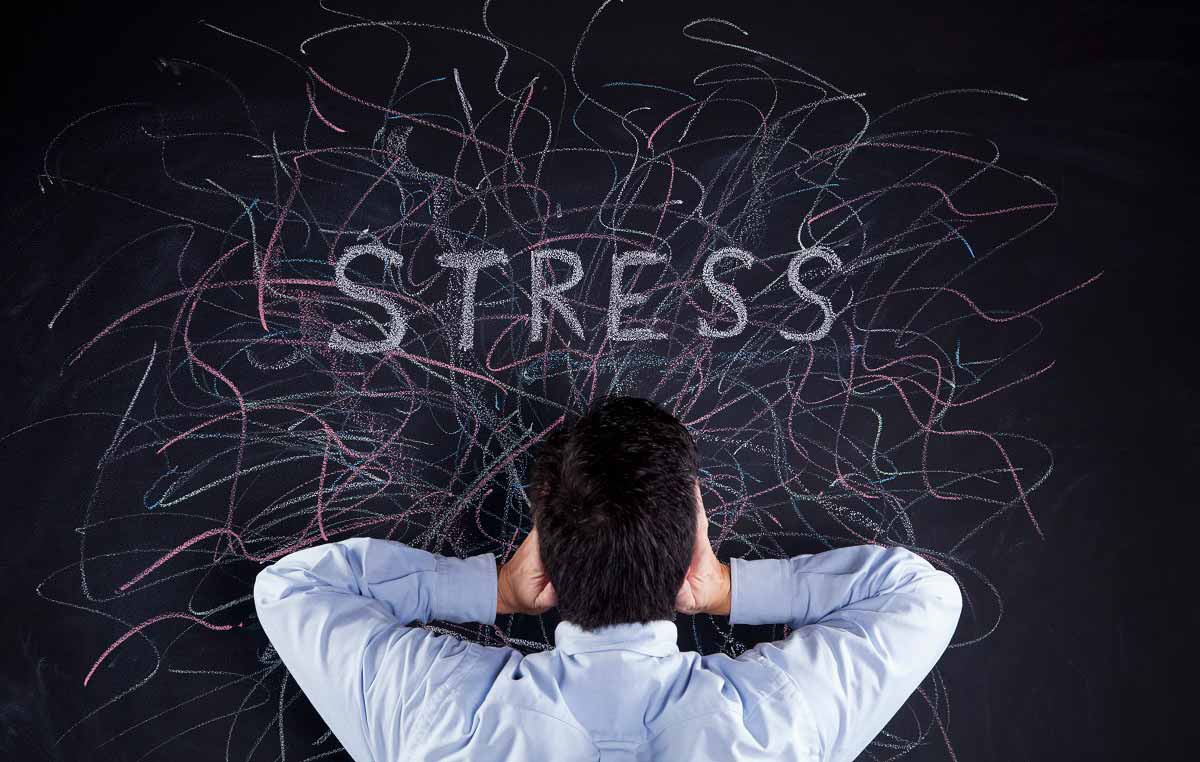What is Stress Anyway?
 First things first, what is stress and how do you know if you’re under it? Many people don’t realize that stress is a very natural and important part of life. Without stress there would be no life at all. We need stress, but not too much stress for too long (distress).
First things first, what is stress and how do you know if you’re under it? Many people don’t realize that stress is a very natural and important part of life. Without stress there would be no life at all. We need stress, but not too much stress for too long (distress).
Our body is designed to react to two types of stress. Good stress helps keep us alert, motivates us to face challenges, and drives us to solve problems. These low levels of stress are manageable and can be thought of as necessary and normal stimulation.
Distress, on the other hand, results when our bodies overreact to events. It leads to what has been called a “fight or flight” reaction. Such reactions may have been useful a long time ago when our ancestors were frequently faced with life or death matters. Our bodies really don’t know the difference between a saber-toothed tiger and a teacher correcting our test. It is how we perceive and interpret the events of life that dictates how our bodies react.
When we view something as manageable, our body doesn’t go haywire; it remains alert, but not alarmed. The activation of our sympathetic nervous system (a very important part of our general nervous system) mobilizes us for quick action. The more we sense danger (social or physical), the more our body reacts.
 Problems can occur when over activation of the sympathetic system is unnecessary. If we react too strongly or let the small overreactions (the daily hassles) pile up, we may run into physical, in addition to psychological problems. Gastrointestinal problems (diarrhea or nausea), depression, or severe headaches can come about from acute distress. Insomnia, heart disease, and distress habits (drinking, overeating, smoking, and using drugs) can result from the accumulation of small distress.
Problems can occur when over activation of the sympathetic system is unnecessary. If we react too strongly or let the small overreactions (the daily hassles) pile up, we may run into physical, in addition to psychological problems. Gastrointestinal problems (diarrhea or nausea), depression, or severe headaches can come about from acute distress. Insomnia, heart disease, and distress habits (drinking, overeating, smoking, and using drugs) can result from the accumulation of small distress.
What we all need is to learn how to approach matters in more realistic and reasonable ways. Strong reactions are better reserved for serious situations. Manageable reactions are better for the everyday issues that we all have to face.
Ways to Manage Stress
W hich effect stress has on you depends on how YOU handle it. How you handle stress depends on being able to recognize it, knowing where it’s coming from, and understanding your stress-management options so you can choose the best one for your situation. Sure, I make this sound easy, it’s not and it takes years to ‘master’, but it’s to never to late to start.
Exercise
 Frequent exercise is probably one of the best physical stress-reduction techniques available. Exercise not only improves your health, it also relaxes tense muscles and helps you to sleep. Exercise has a number of other positive benefits you may not be aware of:
Frequent exercise is probably one of the best physical stress-reduction techniques available. Exercise not only improves your health, it also relaxes tense muscles and helps you to sleep. Exercise has a number of other positive benefits you may not be aware of:
It improves blood flow to your brain, bringing additional sugars and oxygen which may be needed when you are thinking intensely.
When you think hard, the neurons of your brain function more intensely. As they do this, they build up toxic waste products that cause foggy thinking. By exercising you speed the flow of blood through your brain, moving these waste products faster.
It can cause release of chemicals called endorphins into your blood stream. These give you a feeling of happiness and well-being.
Breathing Control
Deep breathing is a very effective method of relaxation. It is a key element of everything from the “take deep breaths” approach to calming someone down, to yoga relaxation and Zen meditation. It works well in conjunction with other relaxation techniques, such as progressive muscular relaxation, relaxation imagery and meditation to reduce stress.
Progressive Muscular Relaxation
 Progressive muscular relaxation (PMR) is a purely physical technique for relaxing your body when muscles are tense. The idea behind PMR is that you tense up a group of muscles so that they are as tightly contracted as possible. Hold them in a state of extreme tension for a few seconds. Then relax the muscles to their previous state. Finally you consciously relax them again as much as you can.
Progressive muscular relaxation (PMR) is a purely physical technique for relaxing your body when muscles are tense. The idea behind PMR is that you tense up a group of muscles so that they are as tightly contracted as possible. Hold them in a state of extreme tension for a few seconds. Then relax the muscles to their previous state. Finally you consciously relax them again as much as you can.
You can apply PMR to any or all of the muscle groups in your body depending on whether you want to relax just a single area or your whole body.
Experiment with PMR by forming a fist, and clenching your hand as tight as you can for a few seconds. Then relax your hand to its previous tension, and then consciously relax it again so that it is as loose as possible. You should feel deep relaxation in the muscles.
You might be able to relax muscles as much without the initial tension, but tensing the muscle helps to provide a starting point for the exercise. It also helps to gauge the initial level of tension in the muscle.
For maximum relaxation you can use PMR in conjunction with breathing techniques and imagery.
Imagery In Stress Reduction
 Imagery is a powerful method of stress reduction when combined with physical relaxation methods such as deep breathing and PMR.
Imagery is a powerful method of stress reduction when combined with physical relaxation methods such as deep breathing and PMR.
We are all aware of how certain environments can be very relaxing, while others can be intensely stressful. The principle behind the use of imagery in stress reduction is that you can use your imagination to recreate a place or scene that is very relaxing. The more intensely you use your imagination to recreate the place or situation, the stronger and more realistic the experience will be.
What is imagery?
The human brain is a mass of nerve cells. Your sense organs (eyes, ears, nose, etc.) convert signals from your environment into nerve impulses. These feed into the areas of your brain that interpret that environment. Imagery seeks to create a similar set of nerve impulses that can feed into those areas of the brain that experience the outside world.
You can use imagery in the following ways to reduce stress:
One common use of imagery in relaxation is to imagine a scene, place, or event that you remember as peaceful, restful, and happy. You can bring all your senses into the image, with sounds of running water and birds, the smell of lavender, the taste of cool spring water, the warmth of the sun, etc. Use the imagined place as a retreat from stress and pressure. Your image can be anything that works for you, as long as it feels peaceful. Scenes can involve complex images such as lying on a beach in a deserted cove. There you may “see” cliffs, sea and sand around you, “hear” the waves crashing against rocks, “smell” the salt in the air, and “feel” the warmth of the sun.
Imagery in preparation and rehearsal
You can also use imagery as a “rehearsal” before a big event, allowing you to run through the event in your mind. It allows you to practice in advance for anything unusual that might occur, so that you are prepared and already practiced in handling it. This helps to give you the self-confidence you need to do something well.
Many athletes and performers use this method. Recently, this writer heard a professional golfer admit that he imagined himself playing a particular hole in a tournament before he actually played. In his mind he envisioned the ball going into the hole even before he putted. It worked — he won the tournament. He believes imagery has improved his game tremendously. This technique can be used in other sports as well or even for musicians.
Meditation
 Meditation is a very effective method of relaxation. The idea of meditation is to focus your thoughts on one relaxing thing for a sustained period of time. It gives your body time to relax and recuperate and clear away toxins that may have built up through stress and mental or physical activity.
Meditation is a very effective method of relaxation. The idea of meditation is to focus your thoughts on one relaxing thing for a sustained period of time. It gives your body time to relax and recuperate and clear away toxins that may have built up through stress and mental or physical activity.
Meditation is particularly useful when you have been physically active, you have been worrying about problems, and you have been under stress for a long time.
Meditation can have the following effects:
- lowers blood pressure
- slows breathing
- helps muscles relax
- gives the body time to eliminate lactic acid and other waste products
- eliminates stressful thoughts
- helps with clear thinking
- helps with focus and concentration
- reduces stress headaches
Meditation Techniques
The essence of meditation is to calm your thoughts by focusing completely on just one thing. Meditation is actually an active process which seeks to exclude outside thoughts by concentrating all mental faculties on the subject of meditation.
First of all, it helps if your body is relaxed. It should be done in a position that you can comfortably sustain for a period of time (20 – 30 minutes is ideal). If you choose, and you are sufficiently supple, then the lotus position may be appropriate. Otherwise, sitting in a comfortable chair or lying on a bed may be equally effective.
A number of different focuses of concentration may be used. Which one you choose is a matter or personal taste. Some of these are:
Breathing
A useful method may be to focus your attention on your breathing. Concentrate on breaths in and out. You can accompany this by counting your breaths using the numbers 0 to 9. You can visualizing images of the numbers changing with each breath. Alternatively you could visualize health and relaxation flowing into your body when you inhale, and stress or pain flowing out when you exhale.
Focus on a sound
Some people like to focus on sounds. The classic example is the Sanskrit word “Om”, meaning “perfection”. Whether or not this is practical depends on your lifestyle.
Imagery
![]() This can be a very refreshing and pleasant way of meditating. Here you create a mental image of a pleasant and relaxing place in your mind. Involve all your senses in the imagery. If external thoughts or distractions wander in, try to make them drift out by attaching the thoughts to objects and then move the objects out of your mind. This takes time to learn how to do effectively.
This can be a very refreshing and pleasant way of meditating. Here you create a mental image of a pleasant and relaxing place in your mind. Involve all your senses in the imagery. If external thoughts or distractions wander in, try to make them drift out by attaching the thoughts to objects and then move the objects out of your mind. This takes time to learn how to do effectively.
You may find that your attention keeps when you first start to meditate. You will find that as you practice meditation your attention will improve. Keep in mind that meditation can take months or a year or longer to master, but you will find that meditation enhances many aspects of your life.
- To learn Tai Chi Basics and links, go to Tai Chi and check out Self-Massage and Aromatherapy
Chronic Anger
The other type of day-to-day stress response is called chronic anger.
- Are you constantly holding in anger?
- Are there people in your day-to-day life who repeatedly make you angry?
- Do you spend a lot of your time angrily thinking about what certain people said or did to you?
- Do you feel you are a victim of injustice?
 Perhaps you are so angry that you are no longer holding it in. Do you find that interactions with important people in your life are becoming increasingly tense, hostile or explosive?
Perhaps you are so angry that you are no longer holding it in. Do you find that interactions with important people in your life are becoming increasingly tense, hostile or explosive?
Researchers believe that this type of angry, prolonged stress is the most physically unhealthy, particularly for the cardiovascular system. If you suffer from this type of anger-related stress, you should be making some immediate changes in your life!
From tiffs with loved ones or a violent outbursts of “road rage”, anger is something we’re all familiar with. It may be normal — but is it ever healthy? Check out ‘ Anger Management‘ for more on that.
 Join our panel of mental health experts in the video library in our mental heath area as they discuss this powerful emotion and the best strategies for dealing with it.
Join our panel of mental health experts in the video library in our mental heath area as they discuss this powerful emotion and the best strategies for dealing with it.
We usually have someone or something to blame when we’re angry, and most mental health professionals will agree that the true causes of anger lie within. Our panel will discuss personal and social attitudes that encourage us to blow a fuse.
Learn more about job stress, which also applies to overcoming Panic Disorder…
- ALSO… see: Stress Skills and for more on ANGER – go there…
